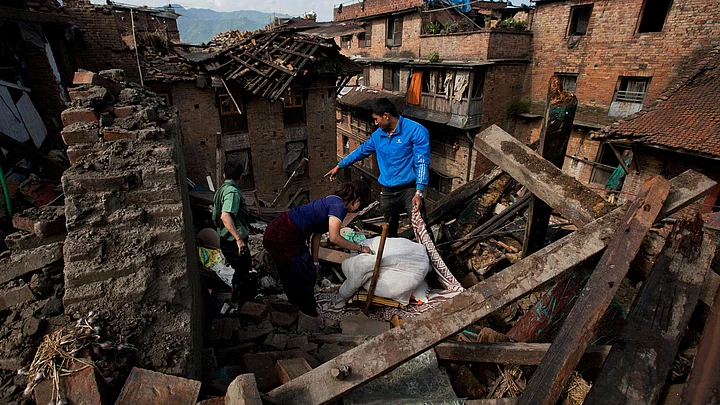Extensive groundwater extraction in the Indo-Gangetic Plain over the last five decades has ‘significantly’ contributed to the killer Nepal earthquake of 25 April 2015, and “probably all earthquakes” in the region beneath the Himalayan arc, Indian scientists claim.
Researchers at NIT Rourkela, CSIR-National Geophysical Research Institute Hyderabad, and National Centre for Seismology (NCS), ministry of earth sciences New Delhi, have gathered evidence of the far-reaching consequences of human actions: how groundwater depletion can “advance the clock” of tremours occurring in the Main Himalayan Thrust (MHT), under the Himalayan arc where the region’s earthquakes originate.
Plate tectonics is the prime driving force behind earthquakes but in the past decade there is a new trend of research. The focus is also on surface and sub-surface activities such as underground mining, fluid injection and reservoir construction due to hydropower projects as possible contributing factors to seismic activity.Bhaskar Kundu, Department of Earth and Atmospheric Sciences, NIT Rourkela
Earlier, small magnitude earthquakes were considered to be influenced by the seasonal loading and unloading (removal process of groundwater) of the Indo-Gangetic Plain in summer and winter, said NCS director Vineet Gahalaut, one of the authors of the study.
We have shown that great and major Himalayan earthquakes are influenced by the anthropogenic groundwater unloading process in the Indo-Gangetic Plain, which is probably the most intensely irrigated region in Southeast Asia.Vineet Gahalaut, NCS director
The Indo-Gangetic Plain is the most populated region of India, Pakistan and Bangladesh, home to 40 percent of India’s population. Population density is highest in eastern Uttar Pradesh and Bihar in India and northern Bangladesh, leading to very high irrigation activities.
Kundu and his colleagues carried out a novel stress-modulation study in the area, through hydrological and satellite-based observation of ground water depletion by human activity.
Around seven percent of this process (anthropogenic ground water depletion) has contributed to advancement of the clock, that is, the timing of the earthquakes. The saturation level for stress is attained early due to depletion of groundwater. This is quite significant.Bhaskar Kundu, Department of Earth and Atmospheric Sciences
In 2014, geophysicists in the US reported the depletion of groundwater in the San Joaquin Valley, modulating stress levels on the San Andreas Fault and thereby heightening the risk of earthquakes.
It is interesting to note that groundwater unloading (removal) rate is about six times more in the Ganga basin in comparison to that in the San Joaquin Valley.NK Vissa, author
The recent study published in Geophysical Research Letters implies that:
The Nepal earthquake and probably all earthquakes occurring on the MHT beneath the Himalayan arc are influenced by the anthropogenic modulation process related to groundwater extraction in the Indo-Gangetic Plain.
But veteran scientist BK Rastogi, former director general of the Gandhinagar-based Institute of Seismological Research (ISR), maintained that such effects are accountable for minor stress change.
Such effects, if any, may at the most cause minor stress change. The normal tectonic stress is too large.BK Rastogi, former director general, Institute of Seismological Research
Geophysicist CP Rajendran said although the work is a “fresh approach”, he found the model validation “problematic”.
The groundwater depletion in the Indo-Gangetic Plain goes back more than 40 years. We do not find any change in rate of seismicity in the Himalayas during this period. In other words, the frequency of large earthquakes originating from the Himalaya should have gone up if the model is right. We don’t see that. Thus, their model lacks this fundamental validation.CP Rajendran, Geophysicist, Jawaharlal Nehru Centre for Advanced Scientific Research, Bengaluru
(Sahana Ghosh can be contacted at sahana.g@ians.in)
(At The Quint, we question everything. Play an active role in shaping our journalism by becoming a member today.)
